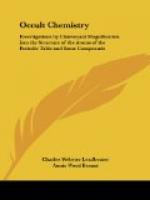In the three whorls flow currents of different electricities; the seven vibrate in response to etheric waves of all kinds—to sound, light, heat, etc.; they show the seven colours of the spectrum; give out the seven sounds of the natural scale; respond in a variety of ways to physical vibration—flashing, singing, pulsing bodies, they move incessantly, inconceivably beautiful and brilliant.[12]
The atom has—as observed so far—three proper motions, i.e., motions of its own, independent of any imposed upon it from outside. It turns incessantly upon its own axis, spinning like a top; it describes a small circle with its axis, as though the axis of the spinning top moved in a small circle; it has a regular pulsation, a contraction and expansion, like the pulsation of the heart. When a force is brought to bear upon it, it dances up and down, flings itself wildly from side to side, performs the most astonishing and rapid gyrations, but the three fundamental motions incessantly persist. If it be made to vibrate, as a whole, at the rate which gives any one of the seven colors, the whorl belonging to that color glows out brilliantly.
[Illustration]
An electric current brought to bear upon the atoms checks their proper motions, i.e., renders them slower; the atoms exposed to it arrange themselves in parallel lines, and in each line the heart-shaped depression receives the flow, which passes out through the apex into the depression of the next, and so on. The atoms always set themselves to the current. The well-known division of diamagnetic and paramagnetic depends generally on this fact, or on an analogous action on molecules, as may be seen in the accompanying diagrams.[13]
Two atoms, positive and negative, brought near to each other, attract each other, and then commence to revolve round each other, forming a relatively stable duality; such a molecule is neutral. Combinations of three or more atoms are positive, negative or neutral, according to the internal molecular arrangement; the neutral are relatively stable, the positive and negative are continually in search of their respective opposites, with a view to establishing a relatively permanent union.
Three states of matter exist between the atomic state and the gaseous—the state in which the chemical atoms are found, the recognized chemical elements; for our purposes we may ignore the liquid and solid states. For the sake of clearness and brevity in description, we have been obliged to name these states; we call the atomic state of the chemist elemental; the state which results from breaking up chemical elements, proto-elemental; the next higher, meta-proto-elemental; the next higher, hyper-meta-proto-elemental; then comes the atomic state. These are briefly marked as El., Proto., Meta., and Hyper.[14]
The simplest unions of atoms, never, apparently consisting of more than seven, form the first molecular state of physical matter.




